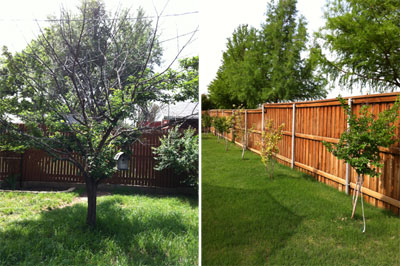Question and Answer – June 2012
Neil answers six to eight questions of the most general reader interest here in each issue of e-gardens. The only ground rule is that the question must be accompanied by a photo. This is, after all, a very visual medium (see below). If you can’t get a photo, Neil invites you to call either of his local or statewide radio programs, or to send your question to the newspapers that carry his Q&A columns. Also, it helps Neil tailor an answer to your specific situation if you will list the city where you live.
Here are this month’s questions.
Question: This red oak was planted two years ago, and now its leaves are turning yellow with spots. What is wrong? Other red oaks nearby look just fine. D., Oak Cliff, near Dallas Zoo.
(Note from Neil: This answer may apply to a similar question sent in by R.W. this month.)
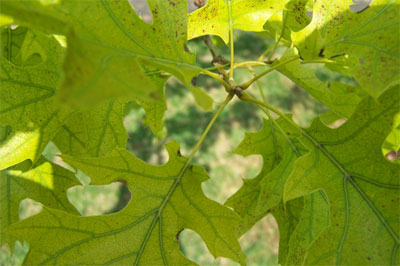
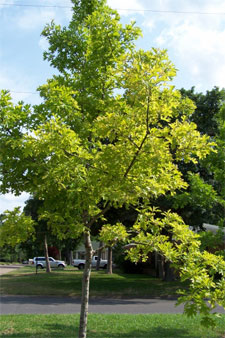
Answer: This is classic iron deficiency, and 98 percent of the time, it’s caused by the tree not being true Shumard red oak (Quercus shumardii), but pin oak (Q. palustris) instead. Nurserymen buy their trees from suppliers they know and trust, but the two oaks are so very similar visually that mistakes are made. The problem with pin oaks in shallow, rocky and alkaline soils is that they will always develop iron deficiency. Because you’re dealing with a tree that should grow tall, wide and deep, you should go ahead and replace it now. If you baby it along for several years, you’ll find yourself spending hundreds and hundreds of dollars annually trying to correct the ever-worsening iron chlorosis. There just isn’t enough iron and sulfur out there to keep this tree happy. I’ve seen hundreds of people try to fight that advice by applying iron additives, and I have yet to see one succeed more than a year or two. Talk to the nursery where you bought it. For the record, check the trunk before you go back to the nursery. Make sure it isn’t suffering sunscald and borer invasion. These can happen when new red oaks are planted, since their bark is quite thin. All new red oak trunks must be protected by paper tree wrap until their leaf canopies are dense enough to provide summer shade. (See question immediately below. It came in just after yours did.)
Question: Three years ago, I planted a Shumard oak in my front yard. It made it through last summer, and it put on leaves beautifully this spring. However, its bark is now peeling away from its trunk and it has lost the leaves from its bottom branches. Our water has a lot of salts in it. Could our sprinkler system be doing the damage? Please help! I love my red oak. A.B., Bryan.

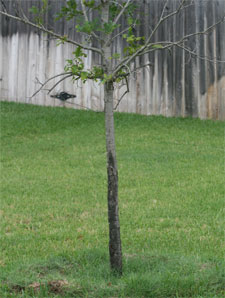
Answer: This is sunscald damage. Young red oaks, also chinquapin oaks, water oaks, willow oaks, Chinese pistachios and a few other trees, have very thin protective bark when they’re young. Trees are grown next to one another in the nurseries, then we bring them home and plant them out in the open. Suddenly, they’re fully exposed to the beating rays of the summer sun. Paper tree wrap applied from the ground up will stop this problem. Leave it in place for one or two years. As to your specific tree, only time will tell. Hopefully, it will catch its breath and heal across the wound. Good luck with it! (The mineral salts in your water had nothing to do with this issue, nor is the problem insect-driven. However, borers can move in behind this type of damage. Since we no longer have any good borer preventive, I hope that’s not how it plays out.)
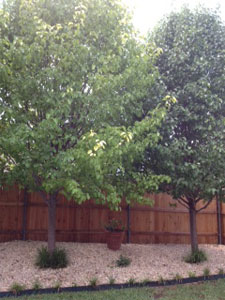
Question: We have five ornamental pears providing fast-growing shade across the back of our yard. They are 10 feet apart. Over the five years that we’ve had them, I’ve noticed that each tree is a different shade of green. One in particular is a pale shade of green, even yellow. What might the problem be? S.W., near Waco.
Answer: Once again, this is iron deficiency, but this answer may vary from the others. Ornamental pears are small enough trees at maturity that you probably could make a case for adding iron and sulfur. In my own experiences with these trees, however, I later found out that the iron chlorosis was showing up because of the very poor branch angles these trees exhibit. Their branches weren’t growing together properly, and the result was an inability to transport iron into the extremities of those branches. That’s what I can tell you from my own experiences. I can’t go much further from this one photo. I’d suggest taking several additional photos to a local independent retail nursery and/or having a certified arborist out to look at the trees on-site. My tree ended up splitting just a couple of years later, and that was when I could see what had been happening to the branches. They’re beautiful trees. Wish they didn’t have this issue with poor branch structures.
Question: What might be wrong with my pentas? The plants are dying just a few days after planting, either because of insects or diseases. H.S., no city given.
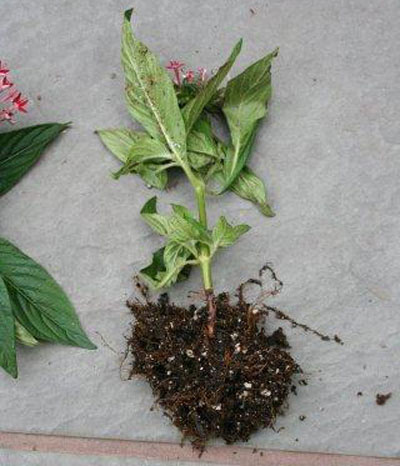
Answer: It may be the disease known generally as "damping off." Pentas are affected by it. It’s actually a combination of several water mold funguses that splash onto the stems. It frequently attacks in seed flats, as plants are just germinating, but it also attacks young plants in wet situations in gardens. Pillbugs will also attack pentas’ stems. Sevin dust will stop the pillbugs if they’re involved. There is no good soil drench for the difficult damping off organisms. I’ve also suffered it on my pentas, and I’ve been careful ever since to plant them in really porous soils. I check my new plants carefully before I buy them, to be sure they’re not already impacted. You can see the lesions on the stems near the ground line.
Question: I planted this hybrid rose five years ago. It has bloomed regularly with its red flowers, but last fall I noticed a new shoot coming off the stem down near the ground. It is a very strong shoot, and it is flowering yellow. Why would this happen? J.P., no city given.
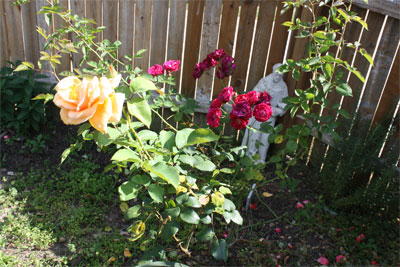
Answer: This is probably the rootstock sending up a shoot. Modern roses are often budded onto different (and stronger) root systems. Choose the one you prefer, and prune out the rest. When this happens, the stronger grower always "wins" if no corrective pruning is taken.
Question: What is causing my waxleaf ligustrum’s leaves to twist? No name, no city given.
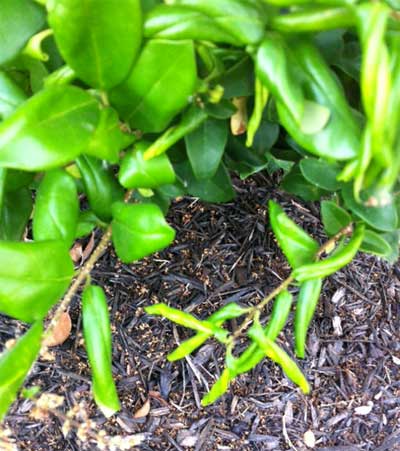
Answer: This is damage done by a weedkiller, either as a spray drift or washing across the soil from granules. It might even have been from a weed-and-feed fertilizer product, but somehow, weedkillers are involved. The ligustrum will probably survive, but it’s going to look odd for the rest of this season.
Question: You’ve written about fire blight on pears and apples. This is my tree. If I spray with agricultural streptomycin, can I eat the fruit? Do I prune and spray now? P.K., no city given.
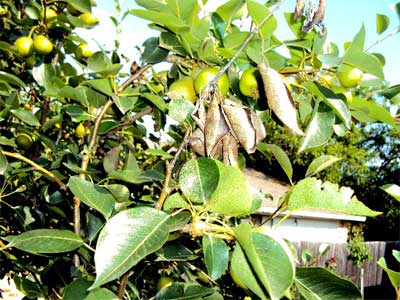
Answer: Prune the damage out, and disinfect your pruning tools, but don’t spray until the tree is in full bloom next spring. That’s the only time the agristrep will be of value. See our much longer story on fire blight this issue.
Question: I recently noticed the leaves on my Shumard red oak are all turning brown around their edges. Does it need some type of fertilizer? M., Plano.
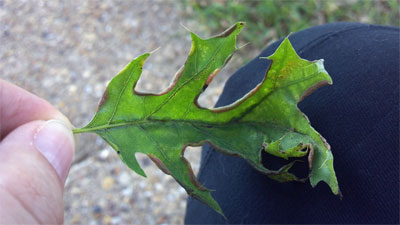
Answer: This is insect damage done by the pocket vein gall. As bad as it looks, it’s actually harmless in the long term. There is no spray for it, so you just need to let it run its course. The tree may even look worse before it looks better. There are scores of types of insect galls that attack various species of oaks. This one has been extremely common this spring – more so than I’ve ever seen.
Question: Virginia creeper has invaded our vinca bed. I’ve been carefully applying a glyphosate product with a foam rubber paintbrush, and it seems to be working. Is this the right thing to do? P.F., Willow Park.
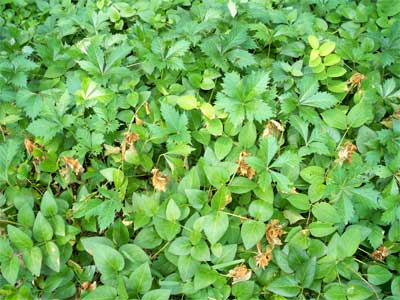
Answer: If you’re happy with the results, go for it! However, when I get this weed in my groundcover beds, I usually attack it with a dandelion digger (narrow cutting hand trowel that’s also called an asparagus knife). I track it back to its origin. The stems trail along for many feet, and all you have to do to kill it is to sever the main stems where they come out of the soil. That would seem to be a lot easier to me. Be careful, of course, to differentiate between Virginia creeper with its five leaflets and poison ivy with its three.
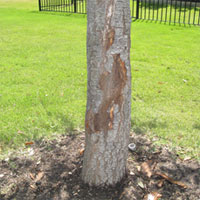
Question: What is causing my live oaks’ bark to fall off? They’re five years old, and we’ve done nothing to harm them. E.R., Robson Ranch (near Denton).
Answer: This is Hypoxylon canker. A friend of mine, Bill Seaman, one of the fine certified arborists with Arborilogical Services in DFW, recently pointed me to the information on their website. It might be of help. (I do point out that they are advertisers in several of my electronic venues, as well as my magazine and radio program. Nonetheless, their help and information is simply the best.) Click here to visit their website information.
Question: What would be wrong with my plum tree? The entire center of the tree has died out. And, why would two crape myrtles in a row be so yellow? K.C., Keller.
Answer: The plum looks like a goner, probably due to either peach tree borers (they also thrive in plum trunks, near the ground level) or bacterial stem canker (small, oozing cracks along the limbs and branches). Both are difficult to prevent and more difficult to cure. It’s time for a new tree somewhere else in your landscape.
As for the crape myrtles, it looks as though they need iron and nitrogen. However, the turf in that area looks just fine, so I’m not sure a shortage of nitrogen is involved. Check their trunks for any signs of injury or mechanical damage from mowers, trimmers, etc.
Question: We need privacy from a two-story house behind us, but our Afghan pines seem to be in trouble. I’ve heard that’s happening all over Texas. What other trees would be better? S.W., Midland.
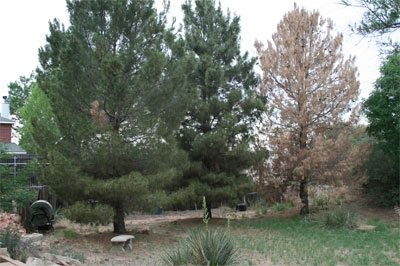
Answer: What you’ve heard is correct. Afghan pines have fallen like flies, both last year and in several other spans during the past 10 or 15 years. They just aren’t totally satisfied with our soils and our climate, and they’ve also struggled with serious disease issues. Most of us have sadly pulled them off our recommended lists. In much of Texas, eastern redcedar juniper would be an ideal replacement. You could use it or one of the other Hill Country species of junipers, but you’ll probably have an easier time finding Little Gem or Teddy Bear southern magnolias as replacements. They’re great trees, although a bit slow-growing. Tree-form yaupon hollies might be yet another option if 15 feet of height is enough. Talk to your local retail nurseryman for additional options.


